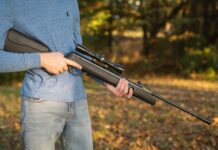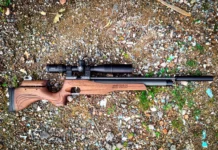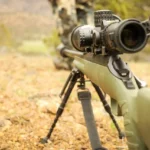The vast majority of Eastern bowhunters hunt from trees, but rarely do they practice from them. Before you ascend, it’s important to understand the ins and outs of treestand trajectory.
The force of gravity upon a traveling object is strongest when parallel to the Earth. Therefore, if your sights are zeroed at ground level, your arrow will impact slightly higher when shooting at both upward and downward angles. Here’s how to maximize accuracy and become more deadly from above.
Table of Contents
Prevent Form Breakdown
Many golfers are PGA-caliber players from the friendly mats of the driving range, but out on the course, the fairways are uneven and footing is shaky. Form breaks down. This is the same with treestands.
Travis “T-Bone” Turner of Bone Collector fame first gained notoriety as a tournament archer. He competed professionally from 1989 to 2002 and won the world championship in 1991. He’s also a hunter who’s taken hundreds of deer from treestands.
“Some people drop their bow arm when shooting down, but that changes the geometry of their form and causes missed shots,” Turner said. “It’s important to bend at the waist.”
To do this correctly, draw and aim as if the target is at your height level, and while holding that form, bend at the waist until your pin is on target.
T-Bone also suggests adding a kisser button to your bow. He says it’s particularly valuable when shooting from a stand, as it forces you to align not only your eye, but also your arms, head, and body properly. It’s a blatant fact that poor and inconsistent form will lead to bigger groups and more wounded deer.
Consider a Specialized Sight
While they have faded in popularity, pendulum-style sights work wonderfully when shooting from treestands at modest distances. They work on a trigonometric function based on the fact that your bow, the target, and the ground form a triangle whose unknown variable (the distance to the target) can be deduced. In layman’s terms, the sight uses gravity to automatically adjust to the correct range.
Once dialed-in for your bow, the sight stays on-target from about 5 to 35 yards or farther, depending on your arrow speed and your height above the ground. The higher you go, the more room the sight has to work before it “bottoms out,” thereby establishing the sight’s maximum distance. For hunters who always shoot from treestands and keep shots under 35 yards or so, pendulums are deadly.
TruGlo’s Pendulum One-Pin adjustable model works amazingly well, plus it can be dialed for ground shooting. That said, any sight you use will work just fine as long as you understand the effect of elevation and master your technique.
Consider Stand Placement and Angles
Of course, you must weigh the height at which you place your stand against the wind and how important it is to get up high to avoid being detected. As a general rule, the higher you go, the tougher the shot. While a deer and its vitals are three dimensional, the backbone can shield arrows. So the greater the angle, the smaller the margin for error in making a double lung hit.
Combine that with the fact that there is often more foliage from the tree canopy to contend with and that it’s rarely practiced, shooting at a downward angle is harder than shooting from the ground. Many bowhunters prefer climbing 20 to 30 feet, but I prefer 12 to 20 feet in typical good-wind situations.
That being said, you must also consider extreme angles. Plenty of deer have been taken while walking directly under bowhunters’ stands, and some actually like the “straight down through the shoulder blades” shot. A matador kills the bull at the end of the faena by threading a sword just by the spine, down through the shoulder blades between the neck and the back, to reach the heart. When done perfectly, it’s poetry. But when missed by a fraction, it’s appalling. It’s the same for bowhunters.
If you miss the heart, you’ll hit one lung. A deer can go a long way on only one lung. If you center the spine perfectly, you’ll paralyze the deer and have him, but if you don’t, it can glance. If there is little chance of the deer entering cover in the next few yards, it’s probably best to wait until the angle becomes less extreme.
Practice From Above
No matter where you set your zero, or what sight you choose, the key to accurate shooting from a treestand is to practice from a treestand – while wearing your hunting gear. All of it.
Get a feel for where your arrows strike in relation to your sights at various heights and distances. Certainly it takes more effort going up and down the tree, but it’ll make you a more efficient bowhunter. Bribe a helper to pull arrows and send them up.
If you hunt more from treestands, consider zeroing your pins from an elevated position. It’s better to be slightly off on the practice range than slightly off while actually hunting.
Tech Tricks
To truly comprehend treestand trajectory, let’s take it back to the beginning. Before rangefinders existed, most hunters would take a length of rope and stretch it from the base of the tree from which they were hunting to various distance markers – trees, bushes, or whatever was available. If the length of rope stretched for 15 yards to the base of a tree inside your shooting lane, you set your pins and shot accordingly. There was just one problem: Picture trying to climb 15 feet to set your stand while holding that rope. Eventually that rope will run out of real estate, hence the difference in true horizontal and linear distance.
Comprehending that equation is, quite simply, a critical part of under-standing arrow flight.
Nowadays, though, any bowhunter with a rangefinder in hand can instantly solve said equation. Bushnell’s Angle Range Compensation (ARC) system is just one example of this technological application. All Bushnell units equipped with ARC will calculate the angle at which you are shooting, then determine how much that angle affects the true horizontal distance to the target. In a blink, the rangefinder displays the actual linear distance, so you can adjust your point of aim. (See Figure 1, above)
But technology doesn’t stop there. Bushnell’s newest innovation for treestand hunters might change the game. The company’s ClearShot system, given proper calibration using two different pin distances, will show you the highest point of your arrow’s trajectory compared to straight line of sight. (See the small line above the crosshairs in Figure 2.) This illustrates that not only is the horizontal distance different from the linear distance in a treestand, but also the angle is not always true. Your arrow flight has an arc. Knowing that arc will allow you to thread the needle between branches and other obstacles when shooting from above interesting.











































